8 Best Prioritization Models in Agile
The product release speed demanded by your users and management can make being a product manager, well, let’s just say, stimulating. You don’t want your team to become another “feature factory.” Still, the tools you’ve tried make it harder to prioritize them without erupting into arguments.
Did you know that only 43% of product teams focus on outcomes? You need new prioritization techniques that help you focus on the quality you deliver, not constant, rushed outputs.
Enter Agile.
Roadmaps using Agile techniques communicate your overall feature objectives while allowing your team to work autonomously, experiment, and be creative. This makes it easier when it comes time to tie your milestones to business goals when management comes a-knockin’.
In this article, we’ll walk you through eight Agile prioritization techniques you can implement to focus your roadmaps, and backlogs, on delivering value, not just pumping out features on demand.
What Are Agile Prioritization Techniques?
The 2023 Annual Product Management Report reveals a truth that you likely live daily: aligning teams on product direction is a massive headache for product managers. Balancing user demand and business objectives is like juggling fireballs (ouch). Agile offers techniques to untangle this mess. It’s your toolkit for determining what takes precedence. It ensures you deliver value while staying focused on the essentials.
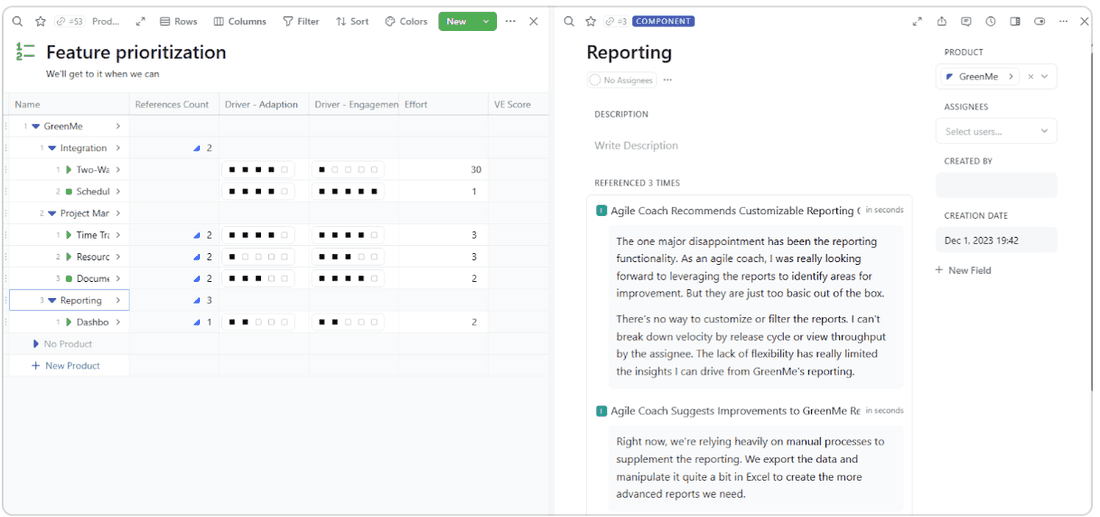
What makes a prioritization technique specific to Agile?
These techniques align with the fundamental principles of Agile methodology. Enshrined in the Agile Manifesto, these principles directly respond to the distinct challenges encountered in Agile product development. Agile, unlike conventional product management methods, is about adaptability. These guiding principles form the bedrock for the eight prioritization techniques we’ll explore.
8 Best Agile Prioritization Techniques
The struggle is real when sorting product work items for a team that can’t agree. Do you sort by urgency, business value, or last-minute client demands?
These techniques provide diverse approaches, so you can cherry-pick the option that syncs with your team’s style. The good thing about all of them is they give you a shared way to prioritize.
MoSCoW
If you’re looking to prioritize your work by criticality, MoSCoW is a great option. Here’s how it’s applied:
- Must-have (M): These are non-negotiable core features to be done immediately.
- Should-have (S): These are necessary but not critical. Ideally, they will be done now, but could be deferred to the next sprint.
- Could-have (C): These are nice to have but not vital. Consider them when higher-priority items are addressed.
- Won’t-have (W): These are deprioritized features, either because they are low value or irrelevant to the current project phase.

Pros
- A straightforward method even with limited detail in the product backlog.
- Helps your team and users align on what is critical rather than “nice to have.”
- Encourages transparency and communication by classifying priorities.
Cons
- May oversimplify complex feature dependencies, so this technique requires you to understand the impact of deferring some features.
- Can look Inflexible if a “won’t-have” item later becomes important or users change their minds (does that actually happen?).
Kano
The Kano Model? It’s the secret sauce for user satisfaction, courtesy of Professor Noriaki Kano. It’s about determining what makes users smile when interacting with a product.
-
Basic needs: These are the core essentials users expect. Think of basic math functions in a calculator app.
-
Performance needs: These features increase user happiness when they work. Imagine AI solving math problems in the app.
-
Excitement needs: These delightful extras make users go “wow.” But if they’re absent, users won’t throw a fit. It’s like snapping a pic of a math problem and getting the answer handed to you.
Basic and performance features? They’re the unsung heroes, doing their job and then some. The excitement features? They’re the bonus rounds that add flavor, but they’re not the main dish.
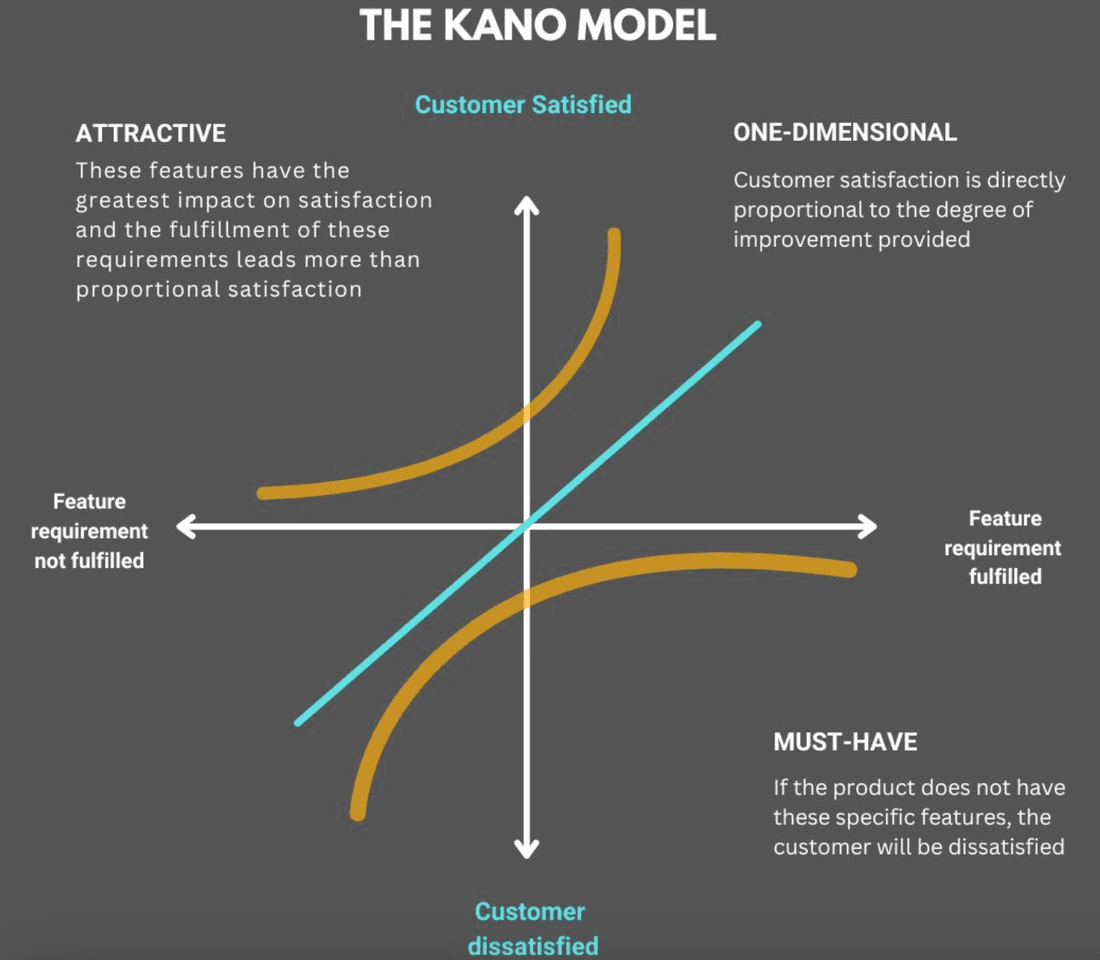
Pros
- Helps you define (and explain) what your users want and what’s most important.
- Shows where there’s a chance to impress your users and stand out from the competition.
- Focuses your approach on user happiness.
Cons
- Well, ya need to know what your users want, which might mean doing research or engaging with users who tend to demand a little too much—use your best judgment here.
- A bit tricky to use, especially for smaller or less experienced teams.
Weighted-shortest-job-first (WSJF)
WSJF, used in the SAFe (Scaled Agile Framework), helps you decide which items in your backlog should be tackled first based on generating maximum fiscal benefit.
It’s really about avoiding the cost of delay (the revenue you’ll miss if you wait) to deliver the work. So you sequence the jobs that can bring the most economic (or other) benefit the fastest.
WSJF looks at a work item’s potential value divided by its job size (effort or duration). This calculation helps prioritize tasks that pack a punch economically. Tasks that bring more value sooner relative to their effort (or duration) get bumped up the list.
Pros
- Zooms in on delivering the most economic value fastest.
- Gives a clear, numbers-based approach to prioritization.
- Helps you allocate resources wisely to ensure you get the best return on investment.
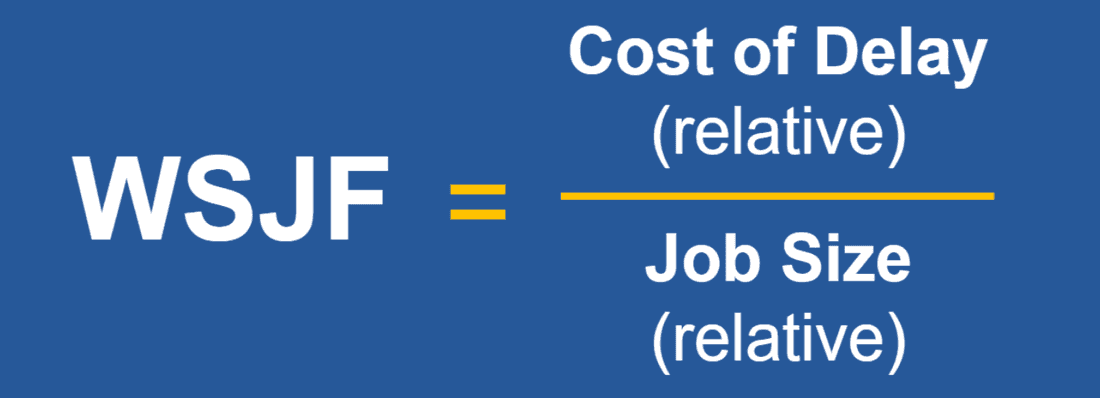
Cons
- Can be complicated if you don’t have the correct estimation of the relative cost of delay per unit of time, and the relative size of the job. You’ll need accurate data on both to get the most out of it.
- Mistakes in your data can lead to picking the wrong priorities and could add more work to the decision-making process rather than saving you time.
Priority Poker
Think of Priority Poker as a game night where everyone gathers to decide which backlog items to tackle first, so prioritization. More often It’s used to estimate the degree of complexity or difficulty for each sprint or product backlog item. It’s also called Planning Poker, and it’s a fun way to score your user stories, which makes prioritizing or estimating feel less like a chore. (Some think it’s so funny as to be out-loud laughable).
Each team member has a deck of cards each with a number on it to estimate the amount of work for each user story, feature, or whatever is in your backlog. Let’s say you’re estimating the relative complexity of user stories.
Often the deck contains only the numbers in a simplified Fibonacci series, up to 100 (sometimes the last number is infinity, meaning it can’t be done).
Then, it’s game on! For each story, the product owner reads the story, then everyone holds up a card with their estimated number. If all agree, it’s on to the next story. If not, your team debates until they agree on the complexity or size of each story.
This shapes up the amount of work to develop the product backlog, if estimating, or determines what gets done first, if prioritizing. And, it could be all wrong, but at least you have consensus.
Pros
- Sparks discussion, which promotes teamwork and engages everyone in the tasks before real work begins.
- Quick-fire decision-making, perfect for picking what goes into the next sprint.
- The team can size tasks up relatively according to a set of values that have been agreed on.
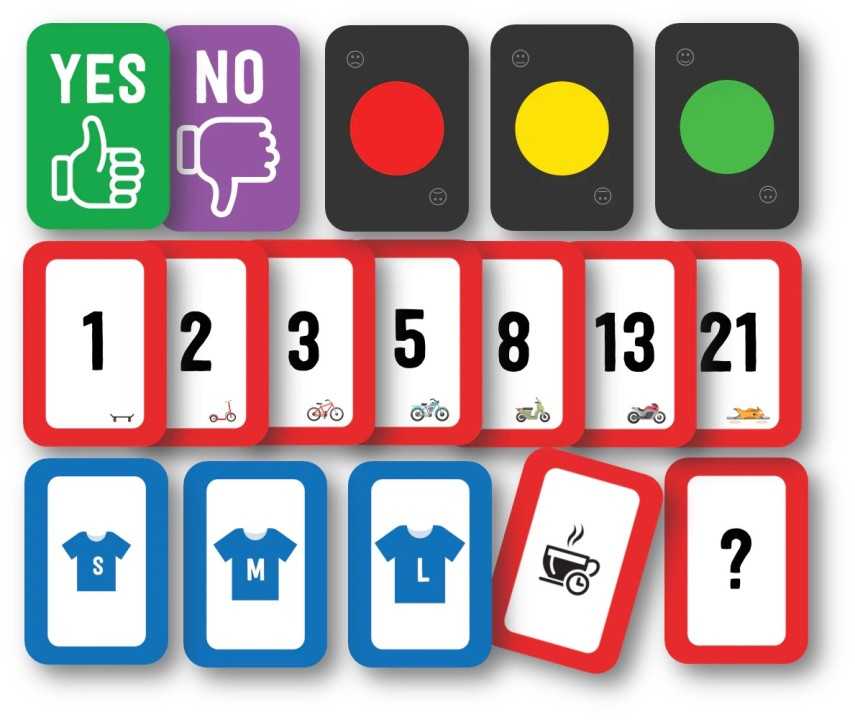
Cons
- Just like the Thanksgiving game of Monopoly that no one asked for, if the team is large or the backlog is complex, Priority Poker sessions can take a while and can get a little heated.
- It’s based on opinion, so clear guidelines are critical to reach a consensus and avoid confusion.
100-dollar test (cumulative voting)
Imagine you’re handed $100 and asked to spend it on what you consider the most important things first. That’s the 100-dollar test, an Agile trick to prioritize features by “spending” more of your “money” on what matters most.
Each person involved gets this hypothetical $100 budget. They play a game, allocating their dollars to the tasks they believe are crucial. The more dollars a task receives, the higher up the priority list it climbs.
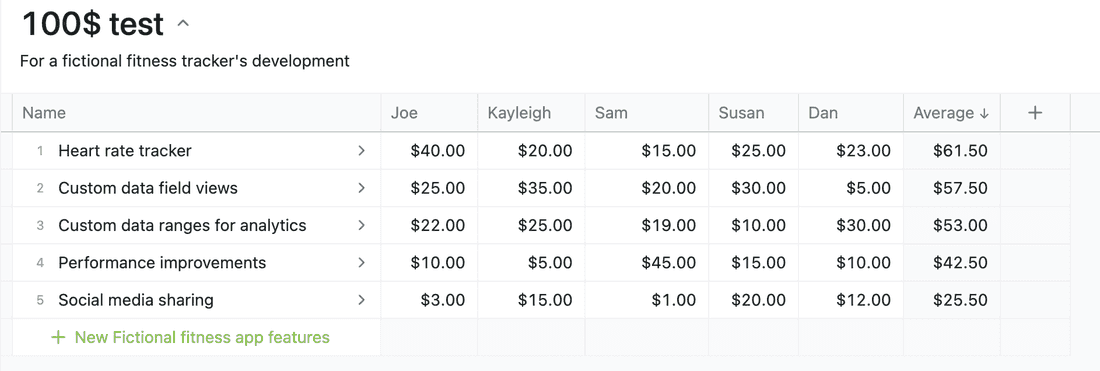
Pros
- Easy for everyone to understand and join.
- Everyone gets a say and actively participates.
- Rapid-fire round-robin process. The technique gives quick results, helping teams decide what to tackle first.
Cons
- Not everything fits into a money-based metric. It might miss out on the finer details of what makes a task truly important.
- Based on individual judgments, objective data or prioritization criteria may not be considered.
Top tip: The 100-dollar test is a nifty way to shake things up and get the team looking at the backlog from a different angle. You can use it to refine the sprint backlog and decide what needs to be done right now.
Cost of Delay (CoD)
Cost of Delay (CoD) is like putting a price tag on time. It determines how much cash you lose every moment (well, every month) a feature, task, or project gets delayed. It allows you to make data-driven decisions rather than gut feelings.
Imagine a software development team working on two features for a new mobile app: Feature A and Feature B. The team uses CoD to prioritize them.
- Feature A: Delaying its release by a month would cost $50,000 because it’s critical for a marketing campaign.
- Feature B: Delaying its release by a month would only cost $10,000 because it’s less time-sensitive. Or it would only bring in $10,000 a month.
When you look at the features this way, it’s simple to decide: prioritizing feature A.
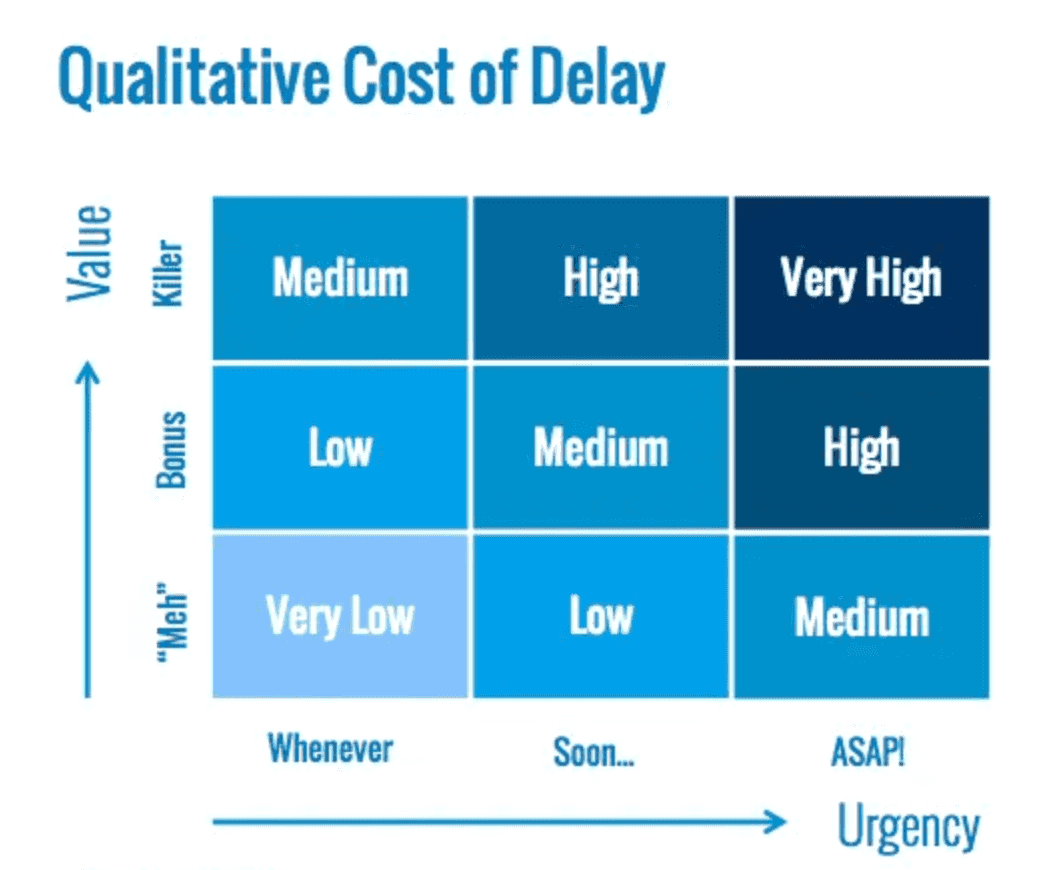
Pros
- Helps in making decisions based on actual financial impacts.
- Zooms in on tasks that can bring in the most revenue.
- Can help give you the numerator for the WSJF technique.
Cons:
- Requires a lot of info and number-crunching to get that cost of delay per unit of time, which can get pretty complex.
- The assumptions behind CoD may shuffle over time, shaking up your decisions.
Business value vs. effort (ROI)
Business value vs effort or business value vs investment (ROI) prioritization is about sizing up each task or feature monetary impact in exchange for the cost or work required to implement it.
While this technique might seem similar to WSJF, WSJF focuses on sequencing for rapid benefit, while business value and ROI focus on a single future number.
Suppose your team is working on a set of new features for an e-commerce platform and considering two potential features for their next sprint.
- Feature X: Implementing this feature is estimated to bring in an additional $50,000 in monthly revenue. If it costs $400,000 to implement, and its life expectancy is two years, the ROI would be 300%.
- Feature Y: Implementing this feature is estimated to bring in an additional $10,000 in monthly revenue. If it costs $120,000 to implement it, and its life expectancy is 3 years, the ROI would be 150%.
Both have attractive ROIs. If you’re just looking at ROI, it’s easy to pick one. Lots of organizations use ROI a lot.
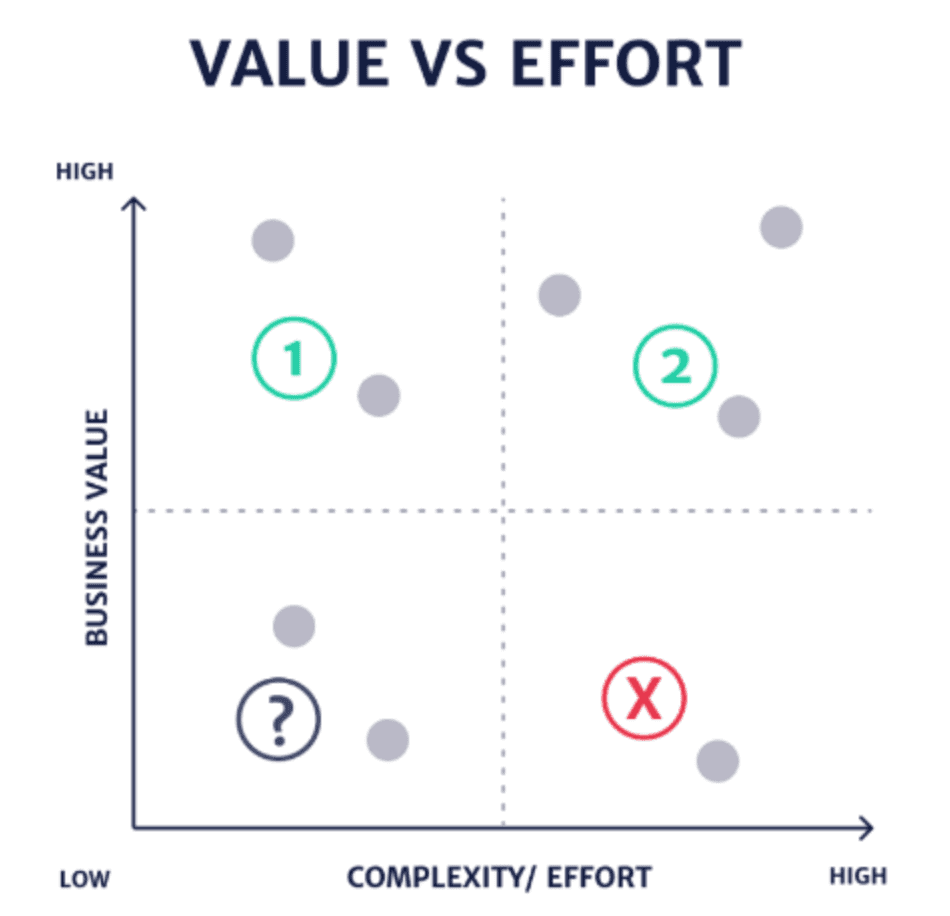
Pros
- Ahem, estimates the future returns of products and features, and lets you “know” the juiciest.
- Makes you estimate the actual cost of development (yes, really).
- Using hard figures to make decisions takes the guesswork out of the equation.
Cons
- Snagging those precise numbers? That can be a hunt. And, oh, yeah, predicting the net present value of a number somewhere in the future.
- Inaccuracies in data or assumptions can throw a wrench in your prioritization plan.
RICE (Reach, Impact, Confidence, Effort)
Imagine RICE as the expert scorecard for your tasks or features. It’s like having magnifying glasses that zoom in on four crucial factors: Reach, Impact, Confidence, and Effort—to guide your team in choosing what matters most. And, hey, it’s built into Fibery.
Pros
- RICE looks at user reach, business impact, data reliability, and effort required, creating a comprehensive picture for prioritizing tasks.
- RICE is about facts, not feelings (or fun). It’s a champion for using data and analytics to ensure your decisions are based on solid ground rather than gut instincts.
- It’s like juggling impact and effort. RICE ensures you don’t miss out on high-impact tasks that are low on effort. This creates a sweet spot for prioritization that you can back up with accurate data if there’s any pushback.
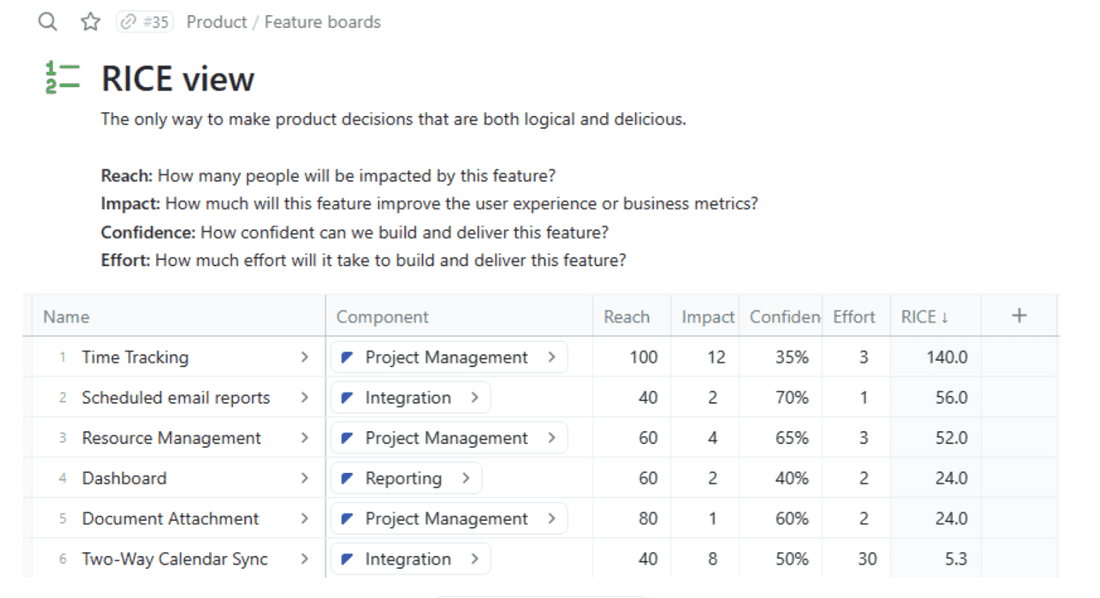
Cons
- RICE’s power lies in data; if you’re under the pump to make backlog decisions quickly, RICE might not be the best fit.
- It’s also a better fit for larger, more complex products with a slightly longer timeline. RICE can get intricate, especially for smaller teams or projects, and the effort might not pay off in the long run.
How to Choose the Prioritization Model That Works for Your Team
The best thing about Agile techniques is that they are made to work for you. You could try them all and see what suits you best. No matter which you choose, here are a few questions to ask yourself:
1. How complex is the backlog I’m trying to choose from? If you’re facing huge projects or a convoluted backlog that haunts your dreams, it might be worth starting with a simpler technique to help you reduce your backlog to a more manageable size. Then, you can prioritize further with a more data-driven approach like RICE to sharpen that list.
- How frequently do you re-prioritize your backlog? If you re-prioritize your backlog regularly to get a rapid economic return, or you are splitting larger jobs into smaller pieces to deliver value iteratively (hey, isn’t that Agile?), you might focus on WSJF.
3. How time-sensitive are my tasks? If you barely have time to think but need to decide immediately, it might not be best to involve the whole team. Pick a few experts and try a technique you can get the most out of on your own and quickly, like MoSCoW.
4. What’s the value or impact? If you’re having one of those days and aren’t sure which category to use, opt for revenue. Prioritize tasks based on their impact or value to your team’s or client’s goals.
5. Which one do I want to use? Sometimes, it just comes down to knowing how you work best. If you have a preference and it gets the job done, go for it. Don’t overcomplicate a process that’s supposed to make your life easier.
The PM’s hot take
Looking for a cure-all? None of these techniques are. In fact, as long as you’re looking for a Swiss army knife type of framework, you’ll keep getting disappointed. You know your problem space. You know the scope, the stakeholders, the resources, and every other parameter you need to carefully weigh. So, we cannot tell you which one will work best - it’s up to you to understand which one suits your specific use case best.
Conclusion
Your prioritization technique is only as good as your processes. Still, if you need more of the same, be sure to check our article about 7 prioritization techniques, or if you struggle with your backlog, this piece on backlog prioritization will serve you well.
And in the meantime, why not give Fibery a go? Sign up for your free, 14-day trial now.
Psst... Wanna try Fibery? 👀
Infinitely flexible product discovery & development platform.